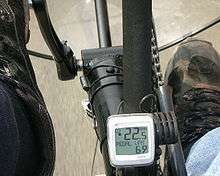Cadence (cycling)
In cycling, cadence (or pedalling rate) is the number of revolutions of the crank per minute; this is the rate at which a cyclist is pedalling/turning the pedals. Cadence is directly proportional to wheel speed, but is a distinct measurement and changes with gearing—which determines the ratio of crank rpm to wheel rpm.

Cyclists typically have a cadence at which they feel most comfortable, and on bicycles with many gears it is possible to maintain a preferred cadence at a wide range of speeds. Recreational and utility cyclists typically cycle around 60–80 rpm. According to cadence measurement of seven professional cyclists during three-week races they cycle about 90 rpm during flat and long (~190 km) group stages and individual time trials of ∼50 km. During ∼15 km uphill cycling on high mountain passes they cycle about 70 rpm.[1]
While fast cadence is also referred to as "spinning", slow cadence is referred to as "mashing" or "grinding".
Any particular cyclist has only a narrow range of preferred cadences, often smaller than the general ranges listed above. This in turn influences the number and range of gears which are appropriate for any particular cycling conditions.[2]
Certain cyclocomputers are able to measure cadence, and relay the reading to the cyclist via a display, typically mounted on the bicycle's handlebars.
See also
- Cycling power meter
- Bicycle gearing
- Tachometer — a motor vehicle's tachometer is analogous to a bicycle's cadence; they are both measurements of the drive-train's rotational speed prior to the "transmission" (derailleur)
References
- Lucía, A.; Hoyos, J. & Chicarro, J. L. (August 2001). "Preferred pedaling cadence in professional cycling". Medicine & Science in Sports & Exercise. 33 (8): 1361–1366. CiteSeerX 10.1.1.453.6997. doi:10.1097/00005768-200108000-00018. PMID 11474339.
- Kifer, Ken. "Cycling Cadence and Bicycle Gearing". Archived from the original on 2012-02-04. Retrieved 2009-05-03.
External links
- Abbiss, C.R.; Peiffer, J.J.; Laursen, P.B. (2009), "Optimal cadence selection during cycling", International SportMed Journal, retrieved 5 May 2015
- Marsh, Anthony P. (Summer 1996). "What Determines The Optimal Cadence?". Cycling Science. Archived from the original on 2011-07-18. Retrieved 20 May 2011.
- Martin, J.C.; Spirduso, W.W. (2001). "Determinants of maximal cycling power: crank length, pedaling rate and pedal speed" (PDF). Eur J Appl Physiol. 84 (5): 413–418. doi:10.1007/s004210100400. PMID 11417428. Archived from the original (PDF) on 2014-03-20. Retrieved 2014-03-20.